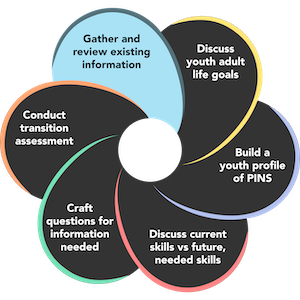Key Takeaways
Now that we better understand age-appropriate transition assessment and who may have transition assessment data to share, let’s work through our entire 5 Step process identified in our introductory video above. Next, we will move into Question One: What do we currently know about the youth’s adult life goals?.
Before doing so, please check out this section’s Key Takeaways, Tools, and Case Studies below. Each section will be structured in a similar way with detailed content for each step, key takeaways, tools, and case studies.

Follow along with the case studies to understand different strategies to support youth at each step of the AATA planning process.
Remember, Age-Appropriate Transition Assessment is NOT a test. There is both formal and informal transition assessment data. Be sure you are including a variety of each that are focused on identifying gaps between the student’s current skills and those needed to achieve his or her adult life goals. Continue to include any past assessment data that is still relevant to the student and their adult life goals.
Be sure to brainstorm (and then include!) anyone who may have transition assessment data about the youth. A multi-agency team has many benefits for all those participating, but ultimately best serves the youth in helping them reach their adult life goals.
